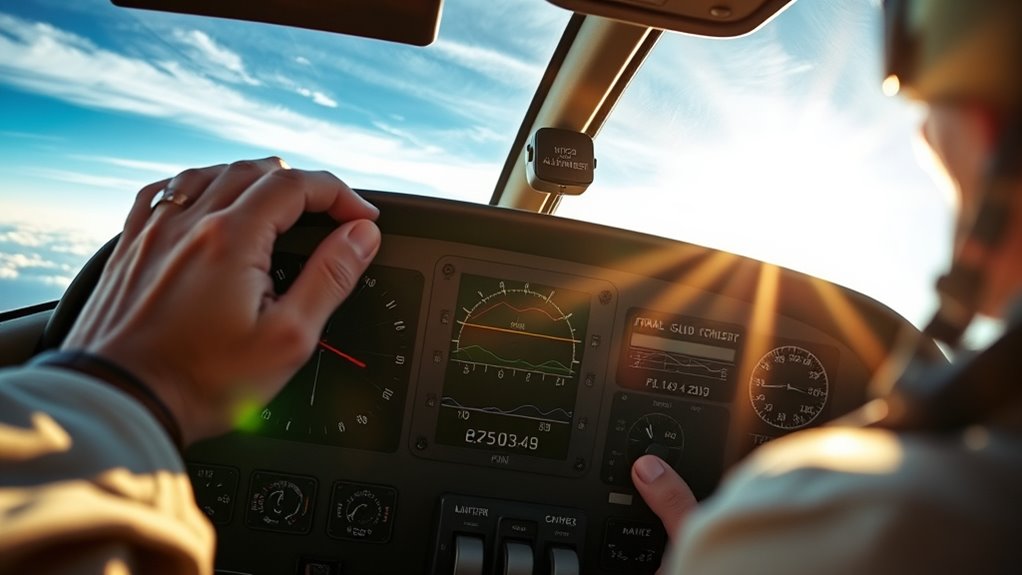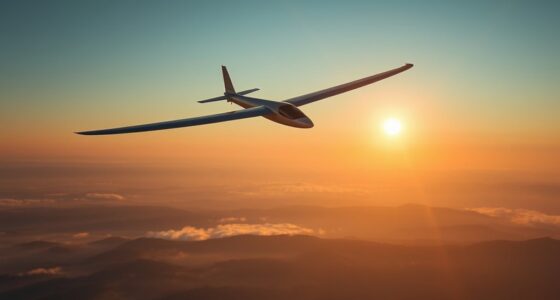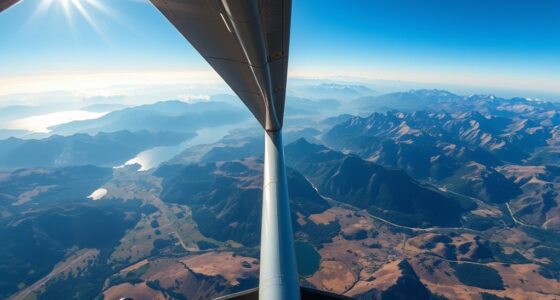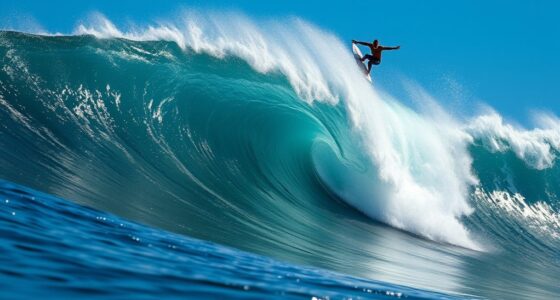To calculate your final glide using MacCready theory, you first estimate the altitude needed to reach your landing spot and consider current weather conditions like wind and thermal strength. You then choose the ideal speed to maximize energy efficiency, balancing your speed with the expected climb rate of nearby thermals. By applying MacCready’s principles, you can fine-tune your glide for safety and efficiency—all the details you’ll uncover as you explore further.
Key Takeaways
- Determine the MacCready (MC) setting based on expected thermal strength for optimal speed during final glide.
- Calculate the glide ratio and adjust speed to balance energy conservation and distance using MC theory.
- Incorporate real-time weather data, including wind and thermal conditions, to refine glide calculations.
- Use MC theory to set the target speed that maximizes glide distance considering aircraft performance.
- Continuously monitor weather cues and thermalling conditions to dynamically adjust the glide plan accordingly.

When planning your descent, accurately calculating your final glide distance is essential to guarantee a safe and efficient landing. Using the MacCready Theory helps you determine the ideal speed to fly between thermalling techniques, maximizing your glide performance based on current conditions. This method considers your aircraft’s glide ratio and the expected climb rate in thermals, giving you a precise target speed that balances speed and energy conservation. This approach is rooted in the principles of Fokos, which emphasize optimizing performance through strategic planning. It’s critical to factor in weather considerations, like wind, thermal strength, and cloud cover, because these elements directly influence your glide distance and safety margin. Ignoring these factors can lead to miscalculations, leaving you short of the landing zone or wasting energy fighting unfavorable conditions.
Accurate glide planning relies on weather, thermals, and MacCready Theory for safe, efficient landings.
To effectively apply the MacCready Theory during your final glide, start by evaluating the thermal activity and weather conditions along your route. Strong thermals can greatly extend your glide, so you may choose to fly faster to take advantage of the lift, but only if the thermal strength justifies the increased speed. Conversely, weak or uncertain thermals suggest a slower speed to conserve altitude and ensure a safe arrival within your planned landing zone. Pay close attention to weather forecasts, wind patterns, and thermal forecasts, adjusting your target speed accordingly. For instance, a headwind can reduce your glide distance, prompting you to fly slightly faster to compensate, while a tailwind can do the opposite.
Thermalling techniques are essential here, as they influence your ability to optimize your glide. Skilled thermalling allows you to climb efficiently and maintain altitude, which directly impacts your final glide calculations. If you’re adept at locating and exploiting thermals, you can extend your glide distance and choose a more aggressive speed. If thermalling is less effective, you’ll need to fly more conservatively, reducing your speed and paying closer attention to weather cues like cloud buildup and thermal indicators. Using real-time weather data, such as variometers and windmeters, helps refine your calculations, ensuring you’re neither overestimating your glide nor risking an under-landing.
Ultimately, integrating thermalling techniques with weather considerations ensures you approach your final glide with a clear, data-driven plan. This approach empowers you to adjust your speed, altitude, and route dynamically, maximizing your glide and increasing your chances of a safe, controlled landing. Remember, the key to successful final glide planning isn’t just in the calculation but in your ability to interpret weather cues and adapt your flying technique accordingly. By doing so, you make the most of every thermal and weather condition to achieve a smooth, confident landing.
Frequently Asked Questions
How Do Weather Conditions Affect Maccready Calculations?
Weather conditions considerably impact your MacCready calculations because of weather variability and thermal dependence. If the forecast predicts good thermals, you’ll set a higher MacCready speed to maximize your glide. Conversely, poor conditions or weak thermals mean you should lower your MacCready setting to conserve energy. Always consider current weather patterns, as fluctuations can change thermal strength quickly, affecting your ideal speed and overall glide performance.
Can Maccready Theory Be Applied to Motor Gliders?
Imagine you’re piloting a motor glider; yes, MacCready theory applies. You focus on your glide ratio and lift-to-drag ratio, adjusting your speed for ideal efficiency. Unlike pure gliders, motor gliders have engines, but when conserving fuel or optimizing glide, MacCready helps you decide the best speed to maximize distance. It’s a useful tool, even with powered aircraft, to balance engine power and aerodynamic performance.
What Are Common Mistakes in Final Glide Calculations?
You often make mistakes in final glide calculations by neglecting to account for your glide path and wind correction. Make certain you accurately measure your altitude and target point, then adjust for wind drift to stay on course. Many pilots forget to include wind correction angles, which can lead to overestimating your glide distance. Double-check your calculations regularly and consider changing wind conditions to improve your accuracy and ensure a safe, efficient glide to the destination.
How Do Pilot Skill Levels Impact Glide Efficiency?
Your pilot proficiency and skill variability directly impact glide efficiency. When you’re more skilled, you better interpret weather conditions and optimize your glide path, conserving altitude and energy. Less experienced pilots may misjudge wind or thermals, leading to inefficient glides. Improving your skills through practice, studying weather patterns, and understanding glide techniques helps you make smarter decisions, ultimately enhancing your glide performance and increasing your chances of reaching your destination safely and smoothly.
Are There Software Tools for Automated Maccready Calculations?
Yes, there are software tools that automate MacCready calculations using software simulation and real-time tracking. You can use apps like XCSoar or SeeYou, which dynamically update glide performance based on current conditions. These tools help you make quick, accurate decisions during flight, optimizing your glide path. With real-time data input, they simplify complex calculations, allowing you to focus more on flying and less on manual math.
Conclusion
By mastering the final glide calculation with MacCready theory, you’ll confidently optimize your cross-country flights. Sure, it might seem complex at first, but with practice, it becomes second nature. Don’t let the initial complexity discourage you—think of it as revealing a secret to better soaring. Once you get the hang of it, you’ll enjoy smoother landings and longer flights, making every glide more rewarding. Keep practicing, and you’ll wonder how you ever flew without it.
With a heart that soars as high as the skies, Aria, affectionately known as “Skylark,” is the driving force behind Soaring Skyways. Her journey into the gliding world began as a young dreamer gazing up at the soaring birds, yearning to experience the weightlessness and freedom they embodied. With years of experience both in the cockpit and behind the scenes, Aria’s commitment to the gliding community is unwavering.










